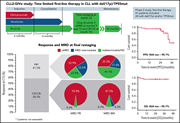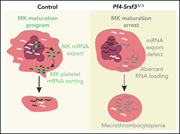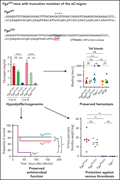Issue Archive
Table of Contents
BLOOD COMMENTARIES
REVIEW ARTICLE
Immune control of cytomegalovirus reactivation in stem cell transplantation
Cytomegalovirus (CMV) reactivation and disease in patients undergoing allogeneic stem cell transplantation (SCT) carry significant morbidity and economic burden. In this review, Degli-Esposti and Hill focus on the immunological and therapeutic factors controlling CMV reactivation and disease after SCT. They look beyond preemptive antiviral therapy, identifying questions needing answers to achieve the goal of guaranteeing early and enduring immunity for SCT patients.
CLINICAL TRIALS AND OBSERVATIONS
A randomized phase 2 trial of idiotype vaccination and adoptive autologous T-cell transfer in patients with multiple myeloma
Clinical Trials & Observations
Qazilbash et al report results of combining adoptively transferred autologous T cells with an antimyeloma cancer vaccine for the treatment of multiple myeloma. Patients receiving the antimyeloma idiotype vaccine in the setting of autologous transplantation had increased expression of immune response genes, but no increase in complete remission or progression-free survival. Given high rates of T-cell exhaustion signatures, the authors speculate that a vaccine strategy combined with checkpoint inhibition might translate increased immune response into better clinical outcomes.
GENE THERAPY
Suppression of fibrin(ogen)-driven pathologies in disease models through controlled knockdown by lipid nanoparticle delivery of siRNA
Fibrinogen is critical for clot formation, but it also contributes to thrombosis, modulates inflammation and immune responses, and facilitates tumor metastasis. Two papers in this issue highlight ways in which low fibrinogen can protect against thrombosis with minimal or no impact on hemostasis. Juang et al assessed the impact of suppressing fibrinogen formation in mice through administration of a nanoparticle-encapsulated small interfering RNA targeting the fibrinogen α chain. Clots formed in vitro had decreased strength, but hemostasis was not impaired in models of bleeding while having salutary effects on inflammation and tumor metastasis. Hur et al created a mouse model of a known human genetic variant of the fibrinogen α chain that causes hypodysfibrinogenemia, demonstrating that mice are similarly protected from thrombosis while preserving hemostasis.
IMMUNOBIOLOGY AND IMMUNOTHERAPY
Nonhuman glycans can regulate anti–factor VIII antibody formation in mice
Brief Report
The most important complication of recombinant factor VIII (FVIII) concentrates is the development of inhibitors. As the recombinant proteins are made in nonhuman cells, Arthur and colleagues examined the role of nonhuman carbohydrate modifications in inhibitor development. They report that nonhuman α-1-3 galactose (αGal) incorporation may provoke anti-αGal antibodies. Since the degree of αGal incorporation varies between species, they propose that the extent of αGal surface expression may influence the product-specific incidence of inhibitor development.
LYMPHOID NEOPLASIA
Obinutuzumab (GA-101), ibrutinib, and venetoclax (GIVe) frontline treatment for high-risk chronic lymphocytic leukemia
Clinical Trials & Observations
Targeted therapies yield better outcomes in patients with high-risk chronic lymphocytic leukemia (CLL) with del(17p) or TP53 mutation, but their survival is still inferior to that of other patients with CLL. Huber and colleagues report a phase 2 study of obinutuzumab, ibrutinib, and venetoclax as a first-line treatment for these high-risk patients. Results were excellent, with 95% progression-free and overall survival at 24 months.
Autologous transplant vs chimeric antigen receptor T-cell therapy for relapsed DLBCL in partial remission
Recent studies have suggested that chimeric antigen receptor (CAR) T cells be moved to second-line therapy for some patients with relapsed diffuse large B-cell lymphoma (DLBCL). Shadman et al retrospectively compared outcomes of autologous hematopoietic cell transplantation (auto-HCT) and CAR T-cell therapy for patients in partial remission after salvage chemotherapy in the Center for International Blood and Marrow Transplant Research database. They found a lower rate of relapse and superior overall survival for patients undergoing auto-HCT. The data suggest that auto-HCT remains the preferred therapy for subgroups of patients with relapsed DLBCL.
MYELOID NEOPLASIA
PP2A is a therapeutically targetable driver of cell fate decisions via a c-Myc/p21 axis in human and murine acute myeloid leukemia
PLATELETS AND THROMBOPOIESIS
The RNA-binding protein SRSF3 has an essential role in megakaryocyte maturation and platelet production
THROMBOSIS AND HEMOSTASIS
Hypofibrinogenemia with preserved hemostasis and protection from thrombosis in mice with an Fga truncation mutation
TRANSPLANTATION
Donor bone marrow–derived macrophage MHC II drives neuroinflammation and altered behavior during chronic GVHD in mice
Neurocognitive dysfunction is present in up to 60% of patients with graft-versus-host disease (GVHD) after hematopoietic stem cell transplantation (HSCT). Adams et al describe the immune landscape of central nervous system (CNS) disease in chronic GVHD (cGVHD). While acute GVHD (aGVHD) is mediated by inflammatory mediators from resident microglia, cGVHD depends on infiltration of the CNS with donor bone marrow derived macrophages. Through analysis of the divergent immune CNS profiles in aGVHD and cGVHD, the authors identify potential targets for addressing CNS cGVHD.
LETTERS TO BLOOD
Booster BNT162b2 optimizes SARS-CoV-2 humoral response in patients with myeloma: the negative effect of anti-BCMA therapy
Clinical Trials & Observations
Constitutional PIGA mutations cause a novel subtype of hemochromatosis in patients with neurologic dysfunction
Muckenthaler et al describe a novel form of hemochromatosis caused by a constitutional PIGA mutation in 3 children with associated neurologic dysfunction. Hemochromatosis results from decreased hepcidin, which is regulated by HFE, hemojuvelin (HJV), and transferrin receptor 2. HJV is a glycosylphosphatidylinositol-linked protein, so PIGA mutation leads to decreased HJV expression. Interestingly, none of the children had evidence of paroxysmal nocturnal hemoglobinuria. The cause of the novel association with central nervous system manifestations remains to be elucidated.
BLOOD WORK
ERRATUM
-
Cover Image
Cover Image
![issue cover]()
A bone marrow aspirate from a patient with congenital dyserythropoietic anemia type III (CDA III) shows a characteristic multinucleated erythroblast. Compound heterozygous variants in RACGAP1 were identified in this patient, implicating the dysfunction of the centralspindlin complex as the basis of this rare form of anemia. See the article by Wontakal et al. on page 1413.
- PDF Icon Front MatterFront Matter
- PDF Icon Table of ContentsTable of Contents
- PDF Icon Back MatterBack Matter
- PDF Icon Editorial BoardEditorial Board
Advertisement intended for health care professionals
Email alerts
Advertisement intended for health care professionals













It takes T to tango: immunotherapy in MM
Clinical Trials & Observations